
Lazy jacks are a great way to control your mainsail as it comes down, but they can also be a real frustration when raising it. The sail battens catch on the lazy jacks and you have to raise the sail a few inches at a time and time the ups perfectly as the lazy jack flips out of the way so the batten doesn’t catch.
There’s usually a bit of “discussion” between the person raising the sail and the one at the helm along the lines of “would you PLEASE hold the boat directly into the wind so I can get this sail up?” We won’t repeat what the person at the helm may be saying. For that reason, lots of people hate lazy jacks.
And I know a number of people who don’t want a stack pack system because it combines a sail cover and lazy jacks into one package.
A quick bit of rigging, however, will make lazy jacks simple to use when raising the main. The secret is being able to move the lazy jacks out of the way when raising the sail (and eliminate the chafe on the sail when sailing) but still have them easily available when you drop the main.
It’s easier to show in pictures, so here goes.
Using Improved Lazy Jacks
Our system – I’ve drawn the lines and blocks in as they didn’t show up well.

To raise the main, you release each lazy jack where it’s cleated on the mast, pull the two lines that are attached to the boom forward, and hook them on the reef hooks or the cleats that the lazy jacks are on. Then tighten up the lazy jack lines. The lazy jacks now form a reverse “L” going along the boom and up the mast.
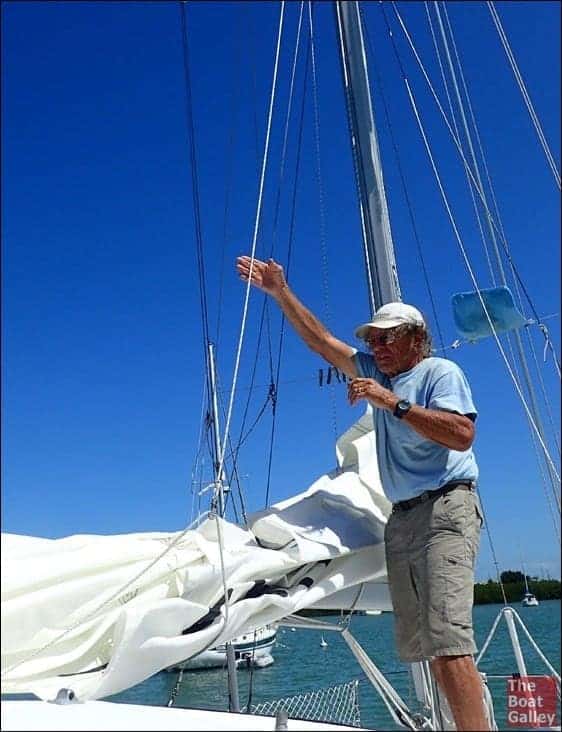

Now, with the lazy jacks out of the way, you can easily raise the main.
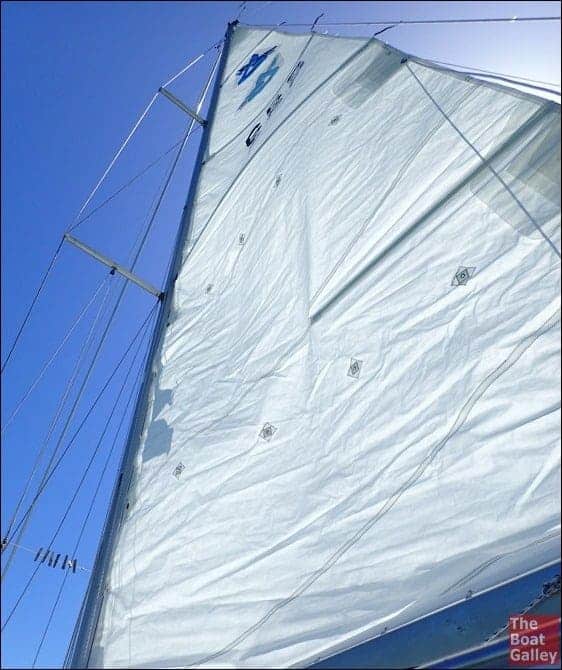
While sailing, we leave the lazy jacks hooked on the mast cleats so they don’t chafe on the main.
Then, when it’s time to take the main down, we unhook the lazy jacks and tighten them up to catch the main.
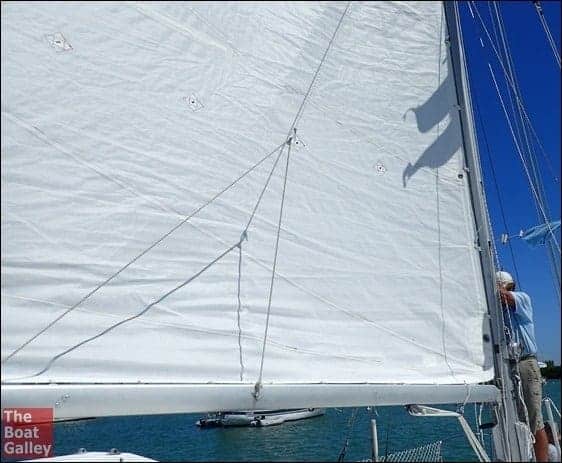
In light air, we can even take the main down without turning into the wind as the lazy jacks nicely corral the sail as it comes down.


It almost flakes itself – a little bit of adjustment and it’s ready for the sail cover.
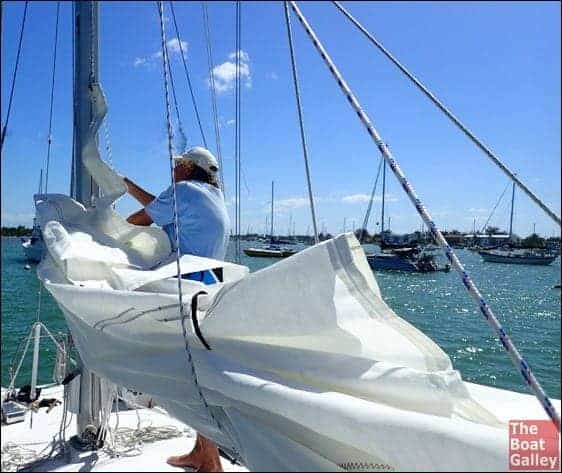
This system works equally well with a stack pack and/or lazy jacks that have three or four attachment points on the boom. We had a stack pack and lazy jacks with four boom (or stack pack, really) attachments on our previous boat (a Tayana 37 with a much larger main sail) and it worked perfectly.
Barefoot Gal had lazy jacks when we bought her, but they were terminated at the mast above the first spreaders. No line back down to deck level. Yes, it drove us nuts. But thanks to whoever had rigged Que Tal those many years ago, we knew exactly how to fix it.
How to Make Your Lazy Jacks Easy to Use
You’ll add a small block on the mast where the lazy jack control line will turn and come down to deck level. Then add a cleat on the mast where you’ll cleat off the lazy jack control line. Finally, you’ll add a longer control line to the lazy jacks.
There is no change to the part of the lazy jack system that is attached to the boom and which goes up to the block where the single control line attaches. The changes are all above that point.
You will need to go up the mast to the point where the lazy jacks attach with a bosun’s chair or another climbing device.
Total cost is $100 to $150 on most boats; time required is two to three hours once you have all the parts.
Preparation
Whip or melt the ends of the new control lines.
Rig up your bosun’s chair or other mast-climbing apparatus and container for carrying tools and parts up the mast with you. Be sure to take the new control lines up with you!
Step One: Add Cleats on Mast
Install the cleats on the mast at a convenient height. You want them to be out of the way of any winches and easy to access.
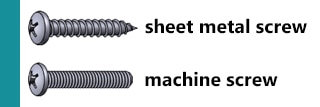
When attaching fittings to the mast, always use machine screws (or rivets) and not sheet metal screws. Halyards and wiring run inside the mast and the pointed tips of sheet metal screws can damage either one.
Drill a hole in the mast and tap it for machine screws. Dab Tef-Gel on the screw threads before putting the screw in to prevent the dissimilar metals seizing.
As a side note, you should also use machine screws or rivets for fittings on the boom, so as not to snag the outhaul or reefing lines running inside.
Step Two: Pad Eyes and Blocks on the Mast
For this step, you’ll have to go up the mast, using a bosun’s chair or whatever mast-climbing device you prefer (see ours). Always use a backup, totally independent system to lessen the chances of injury or death. And be sure to read my tips for keeping people on deck safe while someone is working in the air.
There were already pad eyes on the mast where our lazy jacks were terminated, so all we had to do was shackle a small block (sized for the lazy jack line) on the pad eye.
If you don’t have pad eyes, you’ll have to attach them to the mast, either with machine screws or rivets, then shackle the blocks to the pad eyes.
Use seizing wire or a cable tie to secure the shackle pins so that the pins cannot back out with the motion of the boat.
Step Three: New Lazy Jack Control Line
Before coming back to deck level, pass one of the new control lines through each of the blocks you’ve just installed. You may want to tie the ends together on each side so that you don’t have one go up the mast and come out of the block while you’re coming down (ask me how I know about this possibility!). When tying them together, do it fairly near the ends of each line so you can untie them from the deck.
Once you’re back down on deck, tie one end of each line to the block at the top of the catch lines on each side of the boat, at the point labelled “block” in the drawing below. Cleat the other end on the cleat you just installed.

Parts List
There is very little load on the various parts. We had some items in our spares locker and bought others from Amazon. Due to the relatively light loads, you don’t need heavy-duty or top-of-the-line parts.
- Two small blocks (these are what we used; make sure yours will fit your control line)
- Two shackles to hold the blocks to the pad eyes (size to fit your other hardware)
- Two pad eyes (this 10-pack is a great deal, but don’t use the pointy screws that come with them; buy 4mm stainless machine screws at a hardware or home improvement store)
- Tef-Gel
- Machine screws or rivets for pad eyes
- Seizing wire or cable ties to secure shackle pin
- Two small cleats and machine screws for attaching
- New control line for lazy jacks — the easiest way to measure the length is to go from the aft attachment point of the lazy jacks on the boom to the gooseneck, plus twice the distance from the gooseneck to the pad eye on the mast. This will give you enough line to cleat. You need two pieces this long. Be sure to choose line that is UV-resistant; we like using Sta-Set.
Read Next

Quickly find anchorages, services, bridges, and more with our topic-focused, easy-to-use waterproof guides. Covering the ICW, Bahamas, Florida, and Chesapeake.
Explore All Guides

Carolyn Shearlock has lived aboard full-time for 17 years, splitting her time between a Tayana 37 monohull and a Gemini 105 catamaran. She’s cruised over 14,000 miles, from Pacific Mexico and Central America to Florida and the Bahamas, gaining firsthand experience with the joys and challenges of life on the water.
Through The Boat Galley, Carolyn has helped thousands of people explore, prepare for, and enjoy life afloat. She shares her expertise as an instructor at Cruisers University, in leading boating publications, and through her bestselling book, The Boat Galley Cookbook. She is passionate about helping others embark on their liveaboard journey—making life on the water simpler, safer, and more enjoyable.
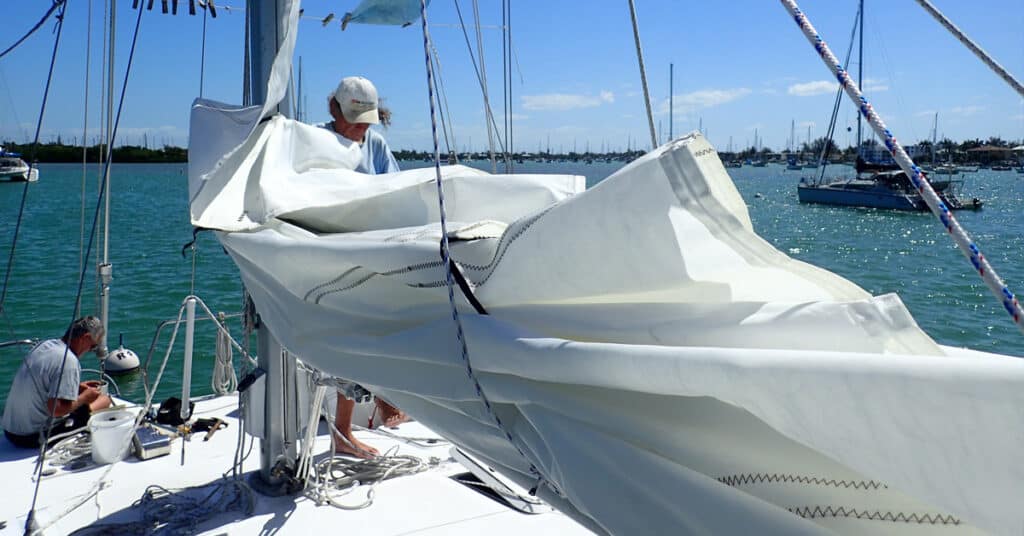










Lucy says
How do you know exactly what we say to each other when raising the main?! Great tips, we will have to do this!
Patty Thompson says
Carolyn I really do love your advice!! Our boat has lazy jacks and we were never quite sure how to take full advantage of it and yes it has been a pain!! Now I can’t wait to do this and try it out! Thank you
Ted Broom says
We made our own maany years ago and that’s how I made them. Figured Relinda didn’t need the hassle of fighting the sail up. She pulls the legs forward to catch them at the gooseneck and hoists. No problems
BEVERLY VENABLE says
We’ve always done this in our home-made set up because I had already made a regular sailcover and didn’t want to put slots in it for the lazy jack, so we pull the lazy jack forward before covering and that way it is out of the way for raising the sail on next trip.
Rodney L Foushee says
Having difficulty with lazy jacks is not a function of the jacks. It is a self-induced problem caused by raising/lowering sails in the wrong order. First up and last down is the head sail. Last up / first down is the main. After making way with the head sail, release the main sheet which allows the main on the boom to wind vane into the apparent wind. Leave the main sheet released. Helmsman pilots with the head sail; crew raises main with no batten snagging because the main system (boom, sail, jacks) is aligned with the wind. After the main halyard is cleated, helmsman trims the main. Same procedure in reverse order for lowering sails. Works in any breeze. Try it.
Keith & Nicki, s/v Sionna says
Rodney, this is great theory, but in many boats – ours included – it simply doesn’t work. Largely this is because with any breeze at all the mainsail is a living thing, luffing and moving randomly as soon as you begin to hoist.
Carolyn’s advice is Stirling, and exactly what our sail maker recommended, with the added benefit of reducing chafe on our main from having the lazy jacks rub against the sail while under way.
Rodney L Foushee says
There is no “theory” with my recommendation – the main sail on your boat, my boat, every boat is subject to the same laws of physics, and, thus, is nothing more than a flag aligned with the wind until the main sheet is tightened. You are correct, the main will move about just like a flag, but what you are missing is that it carries the boom and everything attached to the boom, including the lazy jacks, in alignment along with it.. Head sail first, then the main, it is just too easy.
I’m not questioning the wisdom of the jack system offered here. I’m just offering a practical efficient way of raising and lowering sails without fighting the wind. Simply a tip for the toolbox; don’t like, don’t use it.
Carolyn Shearlock says
I get what you are saying, but as the sail is raised the battens do not stay in alignment with the boom nor do the lazyjacks. They move independently and the battens WILL snag on the lazyjacks.as the sail is raised.
Michael says
Depend on the boat and the sail. The size of the boom and the mast width usually determine the space between the lazy jacks some larger boats have wider boom and mast making the space between the lazy jacks much wider. Some sails are full length battens some have partial Battens. This makes a different in stiffness of the sail and the ends getting hung up or not. Sail shape also makes a difference. I like having the same setup as shown because it allows me to adjust The position of the block that supports the lower lines on the boom. But what works on one boat may or may not be best for all.
Marc Kornutik says
Please allow that your system will not work if lazy jacks are in position.
But I’m still confused because even if none are used or they are pulled out of the way…, once you are sailing after the headsail is unfurled the main is going to fill and billow out to leeward putting a lot of strain on the boltrope, mast track etc. Would be hard to raise and I think it would look quite the mess on deck. Glad it works for you is all I can say, but would love to see a video of you doing it.
Adam Norman says
Hi Carolyn
Another advantage of your excellent system is that you can move the lazy jacks out of the way to the mast cleats when the boat is moored in the marina, thus cutting out chafe and wear on the sail cover if it gets windy while you are away from the boat.
All the best from the UK!
Adam
Margaret says
Going to do this!
Molly says
We’ve had a similar system on our boat for 20 years. It’s great. No chafing, no interference with sail shape.
Bob says
A much cheaper and easier way I came up with is to just unfasten the aftmost attachment of the lazy jacks on both sides of the boom and tie shackles on the ends. Then since it is usually the aft lazy jacks that catch the battens, you can just unshackle them and walk them forward (I snap them together around the mast mounted jib halyard winch.) As long as you remember to walk them aft and reattach them before you lower the main (best to do them one at a time on the windward side of the main to avoid the pressure of the wind on the sail, and do the other on the next tack) it works fine. Granted this does not solve the problem of interference with the sail cover.
Patrick says
I have been doing this for a long time but with a little modification. If you have a long tail on the line that raises your lazy jack you can run it through a small cleat and back up to the first eye on the lazy jack. In this way to lower you just untie the tail and pull down the lazy jack. to raise you do the opposite. You do not end up with a lot of line to deal with as the line that comes down goes up at the same time. I hope this is understandable.
Jason Ellmers says
another thing that will help with snagging issues is to terminate the top most point in the middle of your spreaders and not on the mast at all.. It holds the top away from the centreline.
I have a stack pack with jacks which works like a dream.. Must admit also I don’t have to worry about the blocks the sail might rub on as I have soft spliced eyes at the ends of the rope for the other lines to pass through… Another tip.
Marc J. Kornutik says
Carolyn, excellent system for using just a sail cover. Must disagree though when using it with a stackpack. My lazy jacks also control the tension on the stackpack so it would flop to the sides rather than staying in place. Wouldn’t be realistic to sail that way if lazyjacks were brought fwd out of the way.
It also allows the sail to drop out of it prior to hoisting (no sail ties) so really defeating it’s purpose. That said mine is rigged exactly as you described from the previous owner but I can’t get around the issue of the pack dropping down when those lines are loosened unfortunately.
Carolyn Shearlock says
We had a stackpack with lazy jacks on our previous boat. The sail falling out the pack as we raised the sail was far less of a problem than having the battens catch on the lines in our opinion. One trick is to release one side fully and the other only slightly — keep the boat not perfectly head to wind so that the sail all stays in the slightly released side (it will form a big belly as you partially release the lazy jacks) then bring the boat fully into the wind just as the person at the mast starts raising the sail and the sail starts spilling out. Takes a bit of coordination, but isn’t as hard as it sounds and keeps the sail contained pretty well as it’s being hoisted but also prevents the sail from hanging on the lazyjacks.
You may feel the opposite and prefer to keep the lines in their normal position. And yes, with a stackpack, we did re-tighten the lazyjack lines once the sail was up so that the stack pack laid next to the sail.
Jorge Bermudez says
I only put up the lazy jacks to drop the main. Otherwise they are stored along the boom and mast
Bill Dixon says
We run the “downhaul ” leg aft to the sail cover. It becomes a 3rd lazy jack instead of just another line banging on the mast.
Lili says
Im imterested to learn more ; can you please explain how are you lines connected when sail is up, and how they lay once the sail cover on ? Trying to find the best way to run my lazy jacks and having them away from the mast is music to my ears. Thanks in advance!
Andrent says
We are new boat owners struggling with the stack pack and lazy jacks! Could not figure out what to do, will definitely try your method. Thanks.
Vangelis Christodoulou says
When under way don’t you get the lines fixed on the boom pulling ie not letting the boom swing out?
Carolyn Shearlock says
No, they go to hooks that are quite close to the gooseneck, so there is virtually no difference in length.
Evangelos Christodoulou says
Ok makes sense. Thanks
Anonymous says
Drives me nuts to lower the main without them!
Anonymous says
Mike Drury read this!
Anonymous says
That’s what I have been saying all along 😎 We need to get this rigged up once the new boom bag is made.
Anonymous says
Mike Drury new boom bag is up already on the old lazy jacks! Just needs some finishing off on Monday x
Anonymous says
Des Bradley
Bill Murdoch says
There is a 1994 US patent on the idea. The drawings and description would be helpful in setting up the system. https://patents.google.com/patent/US5327842A/en
Bill
Wanita says
one of the mistakes people make in designing lazyjacks is the height on the mast that causes the batons to get caught on if not perfectly into the wind when hoisting. The mast attachment should be at the lowest point reasonable 45°. i..e. below the spreaders as in the first picture. The sail does not flake up there.